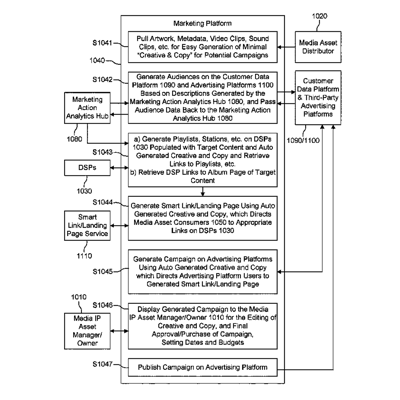- Rockin’ Patent: US Patent No. 11,113,707
- Filed: 22 January 2021
- In the name of: Isolation Network Inc
- Title: Artificial Intelligence Identification Of High-Value Audiences For Marketing Campaigns
- What’s claimed: “A method for authorizing execution of targeted marketing campaigns for streaming media intellectual property (IP) assets, the method comprising: streaming, by media asset consumers, of media IP assets distributed to digital service providers (DSPs) via a media asset distributor, for which the consumers have obtained streaming access through subscription or agreement to other terms of use from the DSPs; documenting and compiling the streaming interactions of the consumer into a transaction-level trend data report, wherein items in the report comprise specific media IP assets; implementing a marketing analytics pipeline that: receives the transaction-level trend data report, compiles the streaming interactions of individual consumers from the transaction-level trend data report into specific geodemographic groups including geographic regions, genders, ages and DSP subscription status, and without identification of individual consumers, creates a ranked list of media IP assets and corresponding marketing actions, retrieves links on the DSPs for the media IP assets in the ranked list of media IP assets, the links being retrieved by use of APIs of the DSP and/or a smartlink API, creates for each media IP asset in the ranked list of media IP assets, using the smartlink API, one or more landing pages comprising the associated links on the DSPs, and creates marketing campaigns for media IP asset managers/owners including the one or more landing pages comprising the links on the DSPs for each of the one or more media IP assets in the ranked list; presenting the ranked list of media IP assets and corresponding marketing actions and marketing campaigns to the media IP asset managers/owners in a graphical user interface (GUI), wherein the GUI includes a media IP asset and a corresponding listing of marketing campaigns, and wherein the GUI enables the media IP asset managers/owners to manage funds, set territory specific budgets and store promotional advertisement material for the marketing campaigns; receiving modifications made via the GUI by the media IP asset managers/owners; and receiving authorization to execute the marketing campaigns from the media IP asset managers/owners, wherein the marketing analytics pipeline comprises: a marketing action analytics hub configured to receive the growth and re-engagement opportunities from an opportunity detection analytics hub or from a marketing platform directly and to identify high growth potential audiences using predictive models of engagement; and a marketing platform configured to interact with the marketing action analytics hub and to create targeted marketing campaigns based around the high growth potential audiences, the marketing platform further being configured to suggest specific marketing actions to the media IP asset managers/owners, wherein the marketing actions are designed for delivery to the high growth potential audiences on appropriate marketing channels via the targeted marketing campaigns; wherein the marketing action analytics hub is comprised of an offline model generation component and an online audience generation component and uses a targeting method based on the specific geodemographic group data compiled from the streaming interactions of individual consumers and the interests of these groups for generating descriptions of high growth potential audiences, wherein the offline model generation component is configured to use the compiled streaming interactions of geodemographic groups contained in a consumption database to fit statistical models based on consumption patterns of an entirety of distributed media IP assets on a regular cadence by clustering media IP assets into categories and employing an alternating least squares framework to generate a specific matrix factorization for each category by approximating an engagement matrix E as a product of two latent factor matrices Eest:=XYτ, where Yτ is the matrix transpose of Y; wherein the choice of the rows and columns of E are informed by the truncation of media IP assets and geodemographic groups based on consumption thresholds, and the values of the entries of E are evaluations of a scalar valued multivariable function ƒ on vectors in a consumption tensor whose dimensions correspond to media IP assets, geodemographic groups, and streaming channels, X is an m×k matrix, Y is an n×k matrix and Eest is itself an approximation of the best rank k≤min(m,n) approximation of E that minimizes a cost function cost ( X , Y ) := ∑ ( i , j ) ∈ S train ( E ij – X i Y j ⊤ ) 2 + λ ( ∑ i ∈ I X i 2 + ∑ j ∈ J Y j 2 ) over all possible choices of X and Y such that Strain and Stest form a partition (disjoint nonempty subsets that cover the whole set) of indices of E, Xi and Yj respectively denote the i-th and j-th rows of the matrices X and Y and I and J are truncated sets of media IP assets and geodemographic groups respectively; wherein λ and k are two hyperparameters for each category determined by a cross validation scheme that minimizes the sum of squared errors SSE(k, λ):=Σ(i,j)∈S test (Eij (k,λ)−Eij)2 using an adaptive grid search where Eij (k,λ) is the (i, j)-entry in the matrix Eest (k,λ) denoting the estimate obtained from the alternating least squares component for a given hyperparameter pair (k, λ), where the chosen k and λ are then used to train the model on the combined train and test dataset, i.e. Strain is now I×J, to minimize the cost(X,Y) to fit Eest=XYτ; wherein ∥Xi∥ and ∥Yj∥ are the l2 norms of Xi and Yj respectively, where the analytic expressions that minimize the cost function for Xi and Yj for a fixed Y and a fixed X respectively are approximated by iteratively applying Xi=(ED(i)Y((YτY+λ·Id)−1)τ)i and Yj=(EτD(j)X((XτX+λ·Id)−1)τ)j, where Id is the appropriately sized identity matrix, D(i) is an n×n diagonal matrix with the j-th diagonal element one if (i, j)∈Strain and zero otherwise, and similarly for the m×m matrix D(j).”
- Why this patent rocks: Those who are familiar with patents will appreciate that the quoted claim is particularly long and includes a relatively large amount of mathematics. The patent appears to relate to Isolation Network Inc’s subsidiary company Ingroove Music Group’s AI-driven music marketing technology. The company states that this technology supports its proprietary Smart Audience advertising solution, which can identify “high-value” streaming audiences for an artist based on listening behaviour. Ingroove Music Group claims that this patent “improves upon [our] ability to discover and deliver high-value streaming audiences.” For a more detailed take, see here.
If you’re a patent-savvy music tech business looking for patent help, get in touch with Russell IP here!
The information above is for general interest and information only and does not constitute legal advice.

